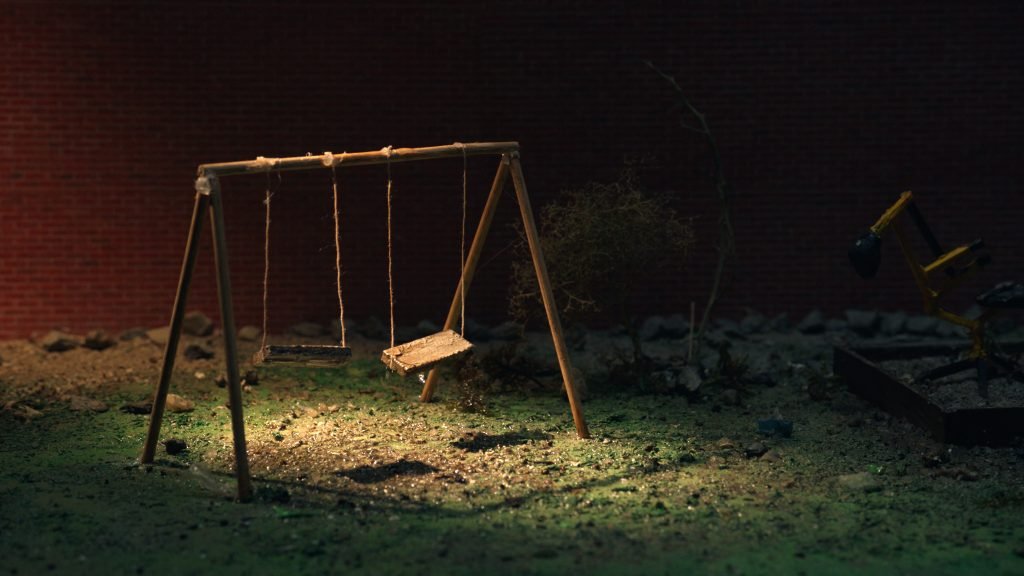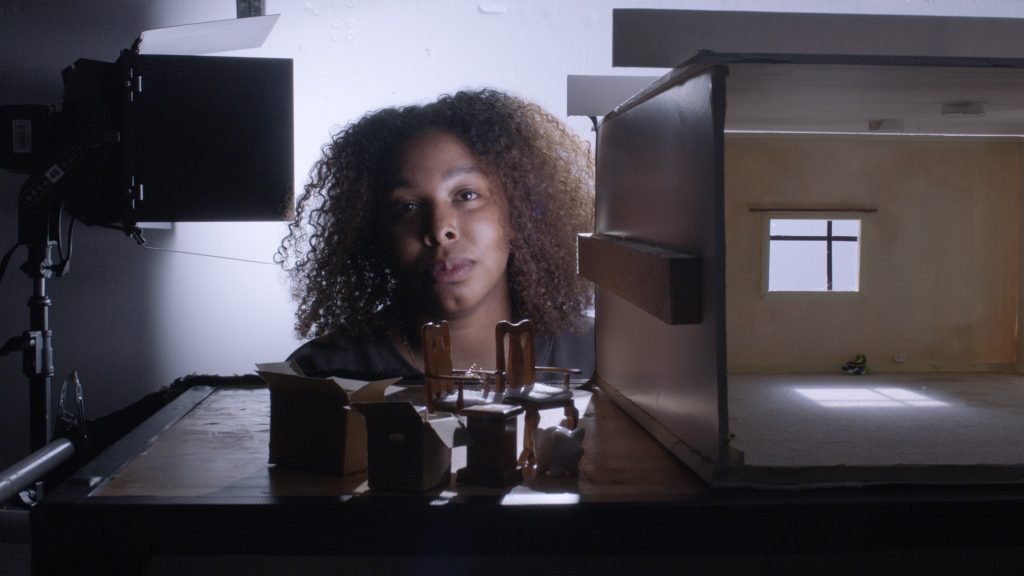Featured Articles
Combining Poetry With Creative Cinematography – An Interview with Signe Rosenlund-Hauglid on ‘A Home on Every Floor”.
Published
2 months agoon

Inspired by a powerful poem by Hanna Asefaw‘s powerful poem, Signe Rosenlund-Hauglid made the documentary film “A Home on Every Floor“. The film delves into pressing issues of gentrification and housing inequality with a creative approach that takes the viewer on a journey through a meticulously crafted miniature world. In this interview, she shares with her the creative process as well as what she believes this film contributes to this conversation that can be relatable to many people across the globe.
1. What inspired you to make this documentary film “A Home on Every Floor,” which adapts Hanna Asefaw’s poem?
Signe Rosenlund-Hauglid:
I was inspired to make this film first and foremost out of admiration for Hanna Asefaw’s poem. She performed it at a festival in 2020, a rare opening in the many pandemic lockdowns, and we had just spent months in our homes due to COVID restrictions.
The text struck me, as well as Hanna’s presence in what she described. She was both confrontational and vulnerable on stage, and I thought it was so visual. With this film, I wanted to explore how text and cinema can work together in a new way, blending spoken words with moving images.
We later started collaborating, adapting the poem into a film, and it was a long development period, again due to more lockdowns in the months that followed. During the pandemic, I also watched several short films by Swedish director and animator Niki Lindroth von Bahr and was very inspired by her world-building, sense of humour and eye for detail. Since the apartment building Hanna grew up in was under construction while we developed the film, we decided to approach the story from a completely different angle and create a whole new world where the film would take place. I think it was production designer Julia Jayko Fossland’s idea, to let the story unfold in a miniature world. And when we got that idea, we knew we had our film.
2. Can you elaborate on the significance of the poem in the context of housing issues and gentrification?
Signe Rosenlund-Hauglid:
Norway has one of the most neoliberal housing markets in Europe, and our politicians have made housing a key driver of economic inequality. Hanna, who is an artist and educated human geographer, has become a known voice in this field over the years, partly because of her activism in a group called «Reduser Husleia» (Decrease the rent), as well as with her poetry through performances.
To me, this poem encapsulates the very meaning of a home, and in that sense, its political. Many neighbourhoods in Oslo suffer from gentrification. The rent is at an all time high, and buying an apartment has become increasingly difficult for those who don’t get help from their parents. People like Hanna are pushed further and further out of the city centre, and hearing her poem in light of this backdrop made me realise that I too had fallen into the trap of thinking of houses as «property» – a thing you can buy and sell for profit, like Ivar Tollefsen, the housing mogul mentioned in the film, does on a large scale.
I hope the film can remind people that what constitutes a home is not its current market value, but the people you share it with, your neighbors and the community surrounding it. I hope the film can evoke questions like: who are our cities really for? and who are the people that tell the stories about the places we belong? in the audience.
3. How did you approach blending elements of documentary filmmaking with the film’s poetic narrative?
Signe Rosenlund-Hauglid:
We worked a lot with the film’s point of view, as Hanna is the key bearer of this story. From early on, I also wanted the poem to be the framework of the film. The film was supposed to start when the poem started and end when the poem ended. We almost managed that.
We used several methods to emphasize Hanna’s point of view. First of all, there is the doll house effect, letting only Hanna intervene with the miniature model, indirectly telling the audience that she is in control of this universe.
As for the development of the story, we also had a unique opportunity. Usually, when making a film, some things need to be explained, so the audience can follow. Here, most of the important things were said in Hanna’s poem, and therefore we were able to experiment with visual metaphors, pace and atmosphere in a different way than I’ve been able to before. We worked a lot with making the film lift the poem, by giving it new layers, there was always the problem of the images competing with Hanna’s words, and it was a fine balance in post-production.
I also wanted the homes presented in the miniature to be relatable to others, especially to Norwegians born in the 90s. We left a lot of nostalgic clues, by including props and TV shows that were typical of that time, and that Hanna had also surrounded herself with. In that way, the story wasn’t just Hannas anymore, but the story of a childhood many can see themselves in and remember.
4. Could you share with us the visual and thematic inspirations for how you portrayed Hanna’s story in this film?
Signe Rosenlund-Hauglid:
In addition to Niki Lindroth von Bahr, I’m inspired by a ton of other filmmakers, both in fiction (Julia Ducournau) and documentary (Gabrielle Brady), to mention a few.
Of course, we also looked at other films dealing with housing, such as Fredrik Gerttens’s «Push» from 2019, but in general, I am inspired by films and art that broaden the boundaries of what’s possible. Making this film, it almost felt like we did something completely new. It’s not animation, it’s not stop motion, it’s just live-action shots in a studio. We were also inspired by artists such as Robert Lepage, who uses miniatures on stage in his show «887». It was a bit fun releasing this film last year, and discovering that Moroccan director Asmae el Moudir had used almost the exact same method as us, working with memories in a documentary. Her film «Mother of all Lies» was screened at Sundance when our film was at Slamdance in January.
5. What was the biggest challenge you faced in adapting the poem into the visual narrative that makes this documentary?
Signe Rosenlund-Hauglid:
One of the biggest challenges was to create images and a soundscape that didn’t compete with Hanna’s text. The poem was written to be performed and heard, not read. Hanna’s presence is key for both the text and the film – without her voice and face, it would be a completely different experience. I wanted to preserve her energy and presence in the film. There were also a lot of challenges with the pace – as we have added a few minutes more than it would usually take her to perform the text on a stage.
In the editing room, we also struggled with progress in the edit, as there was no natural sound connected to the raw footage. It was all shot in a film studio, and I and editor Geir Fjermestad Rolandsen worked with sound designer Ylva Gulpinar in the edit to understand how the film could come alive.
6. Besides her being the writer, in what other ways did you collaborate with Hanna Asefaw throughout the filmmaking process?
Signe Rosenlund-Hauglid:
A Home on Every Floor is subjective, it’s based on Hanna’s experiences, as well as memories from some of her family members and childhood photos from that time. Hanna contributed both in the writing room, and with documentation and perspectives that I didn’t have, growing up in a white middle-class family. It was important to me as a director to acknowledge Hanna’s ownership to the story, and we also collaborated with details in the production design, as well as in post-production, to make the rooms on screen resemble her memories as much as we could.
7. The film employs a unique production design. Could you share more details about the creative decisions behind this aspect?
Signe Rosenlund-Hauglid
We developed a rough, suggestive production design, and created rooms to symbolize the characters Hanna described in the poem, instead of going for a more objective animated technique with actual characters. The rooms in the film give hints of the lives lived there, but never claim to know what those lives actually looked like – I wanted to leave that to the imagination of the audience.
8. The sound design and music contributed also to making this film what it is. Can you share with us what went into that as well?
This question was answered by sound designer and music composer Ylva Gulpinar.
As sound is a highly associative sense, we wanted the soundscape to work as a time capsule, bringing life to the homes by revoking cloudy memories of childhood. We wanted it to feel light, like bittersweet memories, bringing the audience back to their own childhood.
Working with the music we early found that tiny, light sounds both reminded us of children’s instruments, but also felt complementary to the fragile look of the miniatures. By using instruments such as the harmonica and the acoustic guitar, instruments you find in many homes, we wanted to tie the music to the story. Combining the fragile, plucked and fluctuating sounds with the heavier, darker and drony themes, we hoped to capture the nuances, as childhood is not only nostalgic but also deeply serious.
9.What emotions or reactions do you hope to evoke in audiences with this film?
Signe Rosenlund-Hauglid:
I hope this film can evoke both joy and anger. It has had a much larger international audience than we expected, so it feels like we’ve touched a nerve. We see it as a tiny contribution to the ongoing debate about housing policies and hope it can work as a conversation starter.
10. As a journalist turned filmmaker, how does your background influence your storytelling approach?
Signe Rosenlund-Hauglid:
Going into a documentary, I brought with me experience with ethics, research tools, as well as a nerve for writing from journalism. I guess my background has given me a wider understanding of the good and bad sides of exposure, having worked in several national newspapers, often writing about underrepresented groups. My experiences in journalism have made me more humble towards the people I put in front of a camera.
11. Finally, what do you hope audiences will take away particularly from this film in terms of social awareness and activism?
Signe Rosenlund-Hauglid:
I hope this film can make them understand what it’s like to grow up in social housing. When newspapers write about these topics in Norway, they often focus on the bad sides, as I can imagine they do abroad as well. I hope this film can draw the audience into a world they know, but still present them with surprises, while acknowledging when leaving the cinema that housing policies are something we maybe can’t fully control, but have the power to speak up about.
Second on my list of addictions is Movies.. the only thing I could possibly love more is my Dearest Waakye lol. Nothing else does a better job of reminding me that ANYTHING is possible with the right amount of effort. I have great eye for details and flaws in scripts. Shallow scripts bore me. I am an avid reader. Your everyday Mr Nice guy. Always the last to speak in a room full of smart people. Half Human, half Martian but full MOVIE FREAK.

















